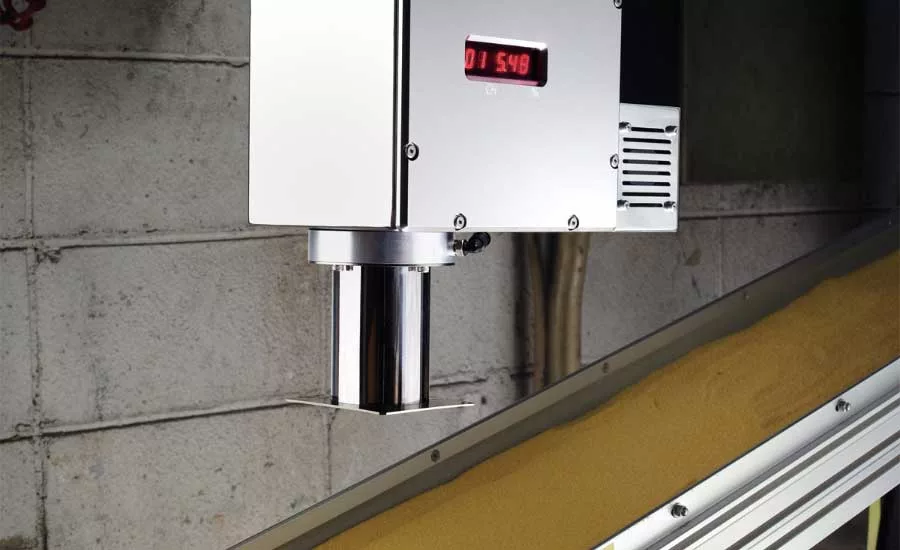Portable devices grab moisture measurements anywhere
While fixed-location, on-line near-IR moisture sensors have been used for some time in several industries, a portable device lets you make spot checks in processes to see where problems are occurring.



There are many places in food and beverage processing where a handheld moisture sensor has distinct advantages over a fixed-mount continuous monitoring device, which is typically located at one point in the process. No doubt, a fixed-location sensor provides a window into the process at that particular monitoring location, but it can’t tell you what’s going on upstream or downstream in the process.
Enter the handheld moisture meter.
A near-infrared (or NIR) handheld moisture meter can help locate a problem in your process without physically touching your product.
You can look at the moisture levels of your ingredients before they’re mixed. You check your products anywhere along the line to understand what might be affecting the moisture level. Is it the humidity level in the room? Is too much water added in the mixing stage? What about baking? Is the product moisture correct? If you’ve used a handheld IR thermometer, then you can make moisture measurements with the same convenience and accuracy.
To get some more information on these devices, Food Engineering Magazine spoke with John Bogart, managing director at Kett US, a manufacturer of a full range of moisture and organic composition meters.
Bogart helped found Kett US in 1989 and has 35 years of engineering and applications development experience. One of Kett’s specialties is moisture measurement, and it has devices for any food or beverage application you can imagine, plus Kett makes several devices for agricultural testing.
The company is located in Orange, Calif., and besides focusing on moisture and organic composition measurement, it also makes friction/wear/surface property analyzers, and specialized agricultural testing instrumentation, which can all be used for process automation and optimization, quality control and quality assurance applications.
FE: Among the types of moisture analysis equipment Kett makes are handheld NIR moisture meters. Why NIR?
John Bogart: NIR moisture meters allow very accurate instant measurement of solids, pastes, and liquids without contact or sample preparation, so there is no contamination in handheld and online models. Once the meter has been calibrated against the lab or production standard, the calibration is stored in the device so no calibration is required in the field. Measurements are fully traceable to the original measurement method.
FE: How does NIR work in making moisture measurements?
Bogart: NIR moisture meters follow the principle that water absorbs certain wavelengths of light,” says Bogart. “The meter reflects light off the sample, measures how much light has been absorbed, and the result is automatically converted into a moisture content reading.
FE: So the device is non-contact, right?
Bogart: Yes. Unlike complex laboratory equipment, portable NIR equipment is designed for ease of use. For example, with Kett’s KJT130 handheld portable instant moisture meter, the user simply points the instrument at the food ingredient and the moisture content is instantly shown on a digital display, with results accurate to 0.01 percent in a 0-100 percent measurement range. Because no direct contact or sample alteration is required, unusual textures and particle size variation are not an issue. This can be important when used with a range of food ingredients in different settings.
FE: How quickly does it take to get a moisture reading?
Bogart: Instantly
FE: How easy is it to use the device? Can a non-engineer use it?
Bogart: For ease of use, the unit is operated via user friendly menu commands. The unit, which is the size of a camcorder, is designed for frequent spot checks wherever necessary, on both stationary and moving (process line) products. Moisture measurement data may be stored in the instrument, downloaded continuously, or manually recorded.
The goal is for any staff member to be able to successfully use the moisture meter wherever it is needed, with minimal required training. This allows food processors to have the certainty that what they are producing is of the highest quality.
The key is to cost-effectively be able to conduct as much testing as required, with full confidence in the results, each and every time.
FE: You mentioned calibration earlier. What is involved in calibrating the instrument before putting it to use?
Bogart: At least two samples of known, different moisture [content] are scanned in the instrument. An optical absorbance value is obtained. The user then obtains the corresponding “lab” moisture value from their current method. The system calculates the relationship between the absorbance values and the moisture measurement. Calibrations remain valid for the life of the instrument.
FE: Is there compensation for measuring moisture levels in different products? In other words, is it like an IR thermometer in that it has to be calibrated or compensated (emissivity) for specific materials, in this case, e.g., flour, salt, baked bread, etc?
Bogart: Yes. Each product should have a calibration. If you have a family of products where the recipe is essentially the same, one calibration may work.
FE: What kind of storage and/or connectivity is available on these devices?
Bogart: Our portable stores up to 99 date-stamped samples. They can be downloaded by the USB serial cable. Our desktop systems have digital interfaces to data collection software (included). Online and inprocess systems have both analog outputs for process monitoring and control and digital interfaces for the included software.
FE: What is the range of capabilities for these devices?
Bogart: We offer three families of products. The widest usage are the “moisture only” systems. We then offer composition meters that simultaneously measure the macro organics (say moisture, protein, fat/oil, alcohol/solvent, fiber, etc.). Our scanning systems can measure multiple sub-categories (say multiple fats or multiple alcohols) within the sample.
For more information: Kett, (800) 438-5388, support@kett.com, www.kett.com.
Looking for a reprint of this article?
From high-res PDFs to custom plaques, order your copy today!







